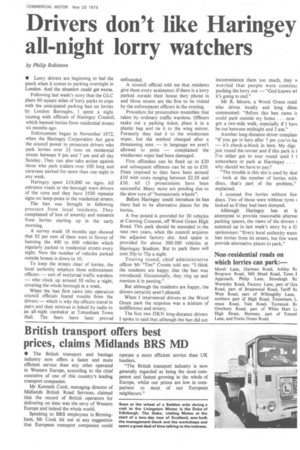Drivers don't like Haringey all-night lorry watchers
Page 23

If you've noticed an error in this article please click here to report it so we can fix it.
by Philip Robinson
• Lorry drivers are beginning to feel the pinch when it comes to parking overnight in London. And the situation could get worse.
Following last week's story that the GLC plans 60 square miles of lorry parks to cope with the anticipated parking ban on lorries by London Boroughs, I spent a night touring with officials of Haringey Council, which banned lorries from residential streets six months ago.
Enforcement began in November 1972, when the Haringey Corporation Act gave the council power to prosecute drivers who park lorries over 2tons on residential streets between 9 pm and 7 am and all day Sunday. They can also take action against those who park trailers over 10ft long and caravans parked for more than one night in any week.
Haringey spent £19,000 on signs. All entrance roads to the borough warn drivers of the zone and they have 3500 repeater signs on lamp-posts in the residential streets.
The ban was brought in following pressure from local residents. They complained of loss of amenity and nuisance from lorries starting up in the early morning.
A survey made 18 months ago showed that 82 per cent of them were in favour of banning the 400 to 600 vehicles which regularly parked in residential streets every night. Now the number of vehicles parked outside homes is down to 10.
To keep the streets clear of lorries, the local authority employs three enforcement officers sort of nocturnal traffic wardens — who clock up around 50 miles a night, covering the whole borough in a week.
When the ban first came into operation council officials feared trouble from the drivers — which is why the officers travel in pairs and their minivan is linked by radio to an all-night caretaker at Tottenham Town Hall. The fears have been proved unfounded.
A council official told me that residents give them every assistance: if there is a lorry parked outside their house they phone in and those streets are the first to be visited by the enforcement officers in the evening.
Procedure for prosecution resembles that taken by ordinary traffic wardens. Officers make out a parking ticket, place it in a plastic bag and tie it to the wing mirror. Formerly they tied it to the windscreen wiper, but the method changed after a threatening note — in language we aren't allowed to print — complained the windscreen wiper had been damaged.
First offenders can be fined up to £20 and subsequent offences can be up to £50. Fines imposed to date have been around £10 with costs ranging between £2.50 and £10. All 13 prosecutions have been successful. Many more are pending due to the slow turn of "bureaucratic wheels".
Before Haringey could introduce its ban there had to be alternative places for the lorries.
A free pound is provided for 30 vehicles at Canning Crescent, off Wood Green High Road. This park should be extended in the next two years, when the council acquires the adjacent factory site. And space is provided for about 200-300 vehicles at Harringay Stadium. But to park there will cost 50p to 75p a night.
Touring round, chief administrative officer Mr "Tim" Cronin told me: "I think the residents are happy that the ban was introduced. Occasionally, they ring up and mention it in passing."
But although the residents are happy, the drivers certainly aren't pleased.
When I interviewed drivers at the Wood Green park the response was a mixture of indifference and misery.
The first two GKN long-distance drivers I spoke to said that although the ban did not
inconvenience them too much, they vi worried that people were continut pushing the lorry out —"God knows wt. it's going to end."
Mr R. Moore, a Wood Green resid who drives locally and long distal commented: "Before this ban came ir could park outside my home . . . now got a two-mile walk, especially if I havt be out between midnight and 2 am."
Another long-distance driver complain "If you get in here after 7 pm you've ha — it's chock-a-block in here. My digs just round the corner and if this park is I've either got to tour round until I f somewhere or park at Harringay . . why should we have to pay?
"The trouble is this site is used by deal look at the number of lorries with discs, that's part of the problem," explained.
I counted five lorries without lice: discs. Two of those were without tyres looked as if they had been dumped.
Although Haringey has at le attempted to provide reasonable alternat parking spaces, the views of the drivers N summed up in last week's story by a G spokesman: "Every local authority want ban lorries from its streets, but few warn provide alternative places to park."
Non-residential roads on
which lorries can park:— Marsh Lane, Garman Road, Ashley Rc Brograve Road, Mill Mead Road, Town I Approach, Philip Lane, Stoneleigh Re Waverley Road, Factory Lane, part of Gra Road, part of Brantwood Road, Tariff Rc West Road, part of Willoughby Lane, northern part of High Road, Tottenham, L rence Road, Vale Road, Tavistock Re Overbury Road, part of White Hart LI High Street, Hornsey, part of Tottent Lane, and Fortis Green Road.
























































































































































